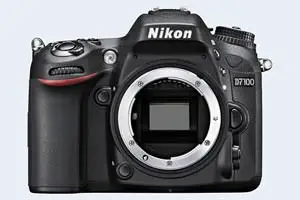Nikon D7100 vs Sony RX10
The Nikon D7100 and the Sony Cyber-shot DSC-RX10 are two enthusiast cameras that were officially introduced, respectively, in February 2013 and October 2013. The D7100 is a DSLR, while the RX10 is a fixed lens compact. The cameras are based on an APS-C (D7100) and an one-inch (RX10) sensor. The Nikon has a resolution of 24 megapixels, whereas the Sony provides 20 MP.
Below is an overview of the main specs of the two cameras as a starting point for the comparison.

Check D7100 offers at
ebay.com

Check RX10 offers at
ebay.com
Going beyond this snapshot of core features and characteristics, what are the differences between the Nikon D7100 and the Sony Cyber-shot DSC-RX10? Which one should you buy? Read on to find out how these two cameras compare with respect to their body size, their imaging sensors, their shooting features, their input-output connections, and their reception by expert reviewers.
Body comparison
An illustration of the physical size and weight of the Nikon D7100 and the Sony RX10 is provided in the side-by-side display below. The two cameras are presented according to their relative size. Three consecutive views from the front, the top, and the rear side are shown. All width, height and depth measures are rounded to the nearest millimeter.
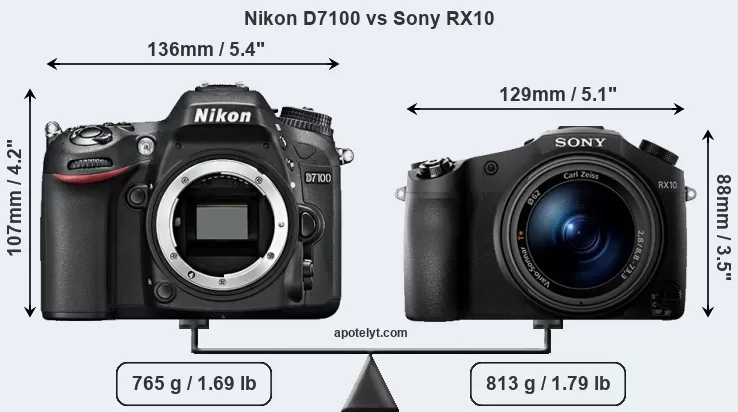
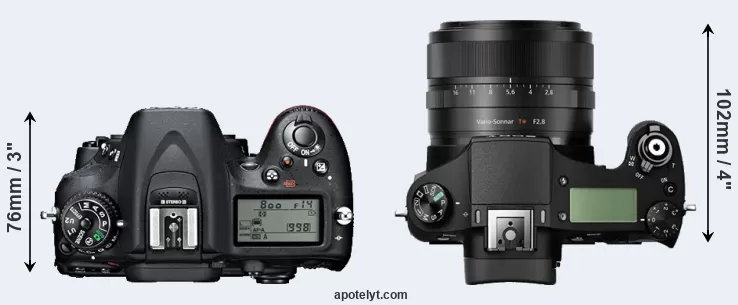
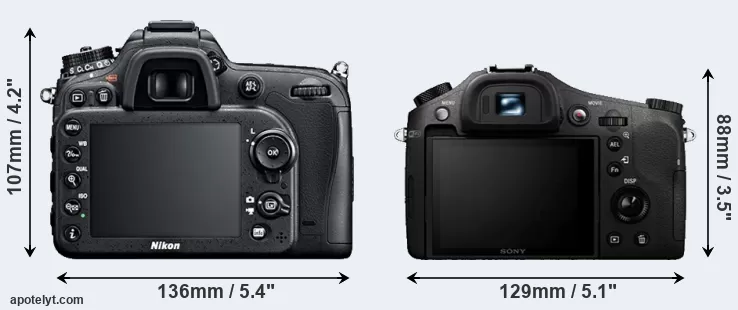
If the front view area (width x height) of the cameras is taken as an aggregate measure of their size, the Sony RX10 is notably smaller (22 percent) than the Nikon D7100. In this context, it is worth noting that both cameras are splash and dust-proof and can, hence, be used in inclement weather conditions or harsh environments.
The above size and weight comparisons are to some extent incomplete and possibly misleading, as the RX10 has a lens built in, whereas the D7100 is an interchangeable lens camera that requires a separate lens. Attaching the latter will add extra weight and bulk to the setup. You can compare the optics available for the D7100 and their specifications in the Nikon Lens Catalog.
Concerning battery life, the D7100 gets 950 shots out of its Nikon EN-EL15 battery, while the RX10 can take 420 images on a single charge of its Sony NP-FW50 power pack. The power pack in the RX10 can be charged via the USB port, which can be very convenient when travelling.
The following table provides a synthesis of the main physical specifications of the two cameras and other similar ones. In case you want to display and compare another camera duo, you can use the CAM-parator app to select your camera combination among a large number of options.

| Camera Model |
Camera Width |
Camera Height |
Camera Depth |
Camera Weight |
Battery Life |
Weather Sealing |
Camera Launch |
Launch Price (USD) |
Street Price |
||
|---|---|---|---|---|---|---|---|---|---|---|---|
| 1. | Nikon D7100 | 136 mm | 107 mm | 76 mm | 765 g | 950 | Y | Feb 2013 | 1,199 | ebay.com | |
| 2. | Sony RX10 | 129 mm | 88 mm | 102 mm | 813 g | 420 | Y | Oct 2013 | 1,299 | ebay.com | |
| 3. | Canon 70D | 139 mm | 104 mm | 79 mm | 755 g | 920 | Y | Jul 2013 | 1,199 | ebay.com | |
| 4. | Canon G3 X | 123 mm | 77 mm | 105 mm | 733 g | 300 | Y | Jun 2015 | 999 | ebay.com | |
| 5. | Nikon D500 | 147 mm | 115 mm | 81 mm | 860 g | 1240 | Y | Jan 2016 | 1,999 | ebay.com | |
| 6. | Nikon D600 | 141 mm | 113 mm | 82 mm | 850 g | 900 | Y | Sep 2012 | 2,099 | ebay.com | |
| 7. | Nikon D610 | 141 mm | 113 mm | 82 mm | 850 g | 900 | Y | Oct 2013 | 1,999 | ebay.com | |
| 8. | Nikon D750 | 141 mm | 113 mm | 78 mm | 750 g | 1230 | Y | Sep 2014 | 2,299 | ebay.com | |
| 9. | Nikon D3300 | 124 mm | 98 mm | 76 mm | 430 g | 700 | n | Jan 2014 | 499 | ebay.com | |
| 10. | Nikon D7000 | 132 mm | 105 mm | 77 mm | 780 g | 1050 | Y | Sep 2010 | 1,499 | ebay.com | |
| 11. | Nikon D7200 | 136 mm | 107 mm | 76 mm | 765 g | 1110 | Y | Mar 2015 | 1,199 | ebay.com | |
| 12. | Nikon D7500 | 136 mm | 104 mm | 73 mm | 720 g | 950 | Y | Apr 2017 | 1,299 | amazon.com | |
| 13. | Panasonic FZ1000 | 137 mm | 99 mm | 131 mm | 831 g | 360 | n | Jun 2014 | 899 | ebay.com | |
| 14. | Sony RX10 II | 129 mm | 88 mm | 102 mm | 813 g | 400 | Y | Jun 2015 | 1,299 | ebay.com | |
| Note: Measurements and pricing do not include easily detachable parts, such as add-on or interchangeable lenses or optional viewfinders. | |||||||||||
The price is, of course, an important factor in any camera decision. The manufacturer’s suggested retail prices give an idea on the placement of the camera in the maker’s lineup and the broader market. Usually, retail prices stay at first close to the launch price, but after several months, discounts become available. Later in the product cycle and, in particular, when the replacement model is about to appear, further discounting and stock clearance sales often push the camera price considerably down.
Sensor comparison
The imaging sensor is at the core of digital cameras and its size is one of the main determining factors of image quality. All other things equal, a large sensor will have larger individual pixel-units that offer better low-light sensitivity, wider dynamic range, and richer color-depth than smaller pixels in a sensor of the same technological generation. Moreover, a large sensor camera will give the photographer more control over depth-of-field in the image and, thus, the ability to better isolate a subject from the background. On the downside, larger sensors are more costly to manufacture and tend to lead to bigger and heavier cameras and lenses.
Of the two cameras under consideration, the Nikon D7100 features an APS-C sensor and the Sony RX10 an one-inch sensor. The sensor area in the RX10 is 68 percent smaller. As a result of these sensor size differences, the cameras have a format factor of, respectively, 1.5 and 2.7. Both cameras have a native aspect ratio (sensor width to sensor height) of 3:2.
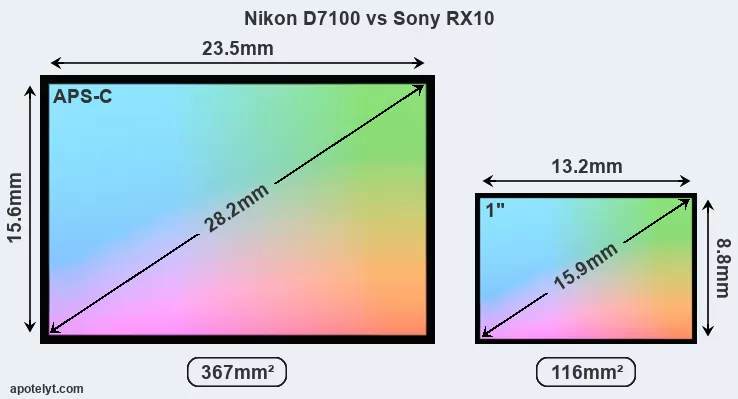
With 24MP, the D7100 offers a higher resolution than the RX10 (20MP), but the D7100 nevertheless has larger individual pixels (pixel pitch of 3.91μm versus 2.41μm for the RX10) due to its larger sensor. However, the RX10 is a somewhat more recent model (by 7 months) than the D7100, and its sensor might have benefitted from technological advances during this time that enhance the light gathering capacity of its pixels. Coming back to sensor resolution, it should be mentioned that the D7100 has no anti-alias filter installed, so that it can capture all the detail its sensor resolves.
The resolution advantage of the Nikon D7100 implies greater flexibility for cropping images or the possibility to print larger pictures. The maximum print size of the D7100 for good quality output (200 dots per inch) amounts to 30 x 20 inches or 76.2 x 50.8 cm, for very good quality (250 dpi) 24 x 16 inches or 61 x 40.6 cm, and for excellent quality (300 dpi) 20 x 13.3 inches or 50.8 x 33.9 cm. The corresponding values for the Sony RX10 are 27.4 x 18.2 inches or 69.5 x 46.3 cm for good quality, 21.9 x 14.6 inches or 55.6 x 37.1 cm for very good quality, and 18.2 x 12.2 inches or 46.3 x 30.9 cm for excellent quality prints.
The Nikon D7100 has a native sensitivity range from ISO 100 to ISO 6400, which can be extended to ISO 50-25600. The corresponding ISO settings for the Sony Cyber-shot DSC-RX10 are ISO 125 to ISO 12800, with the possibility to increase the ISO range to 80-25600.
In terms of underlying technology, the D7100 is build around a CMOS sensor, while the RX10 uses a BSI-CMOS imager. Both cameras use a Bayer filter for capturing RGB colors on a square grid of photosensors. This arrangement is found in most digital cameras.
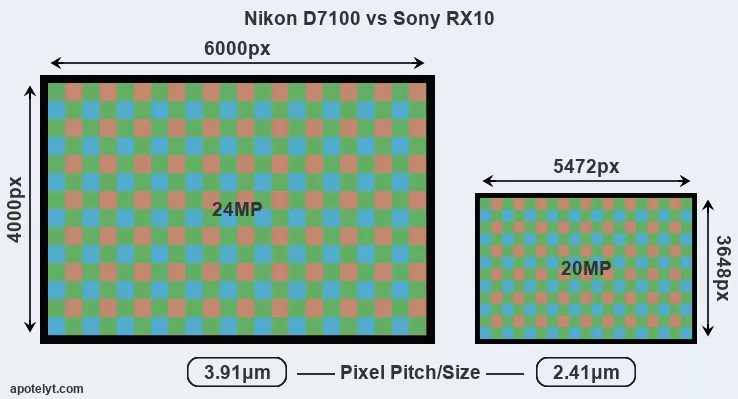
Since 2007, DXO Mark has published sensor performance measurements that have been derived using a consistent methodology. This service assesses and scores the color depth ("DXO Portrait"), dynamic range ("DXO Landscape"), and low-light sensitivity ("DXO Sports") of camera sensors, and also publishes an overall camera score. Of the two cameras under review, the D7100 provides substantially higher image quality than the RX10, with an overall score that is 14 points higher. This advantage is based on 1.3 bits higher color depth, 1.1 EV in additional dynamic range, and 1.4 stops in additional low light sensitivity. The following table provides an overview of the physical sensor characteristics, as well as the sensor quality measurements for a selection of comparators.

| Camera Model |
Sensor Class |
Resolution (MP) |
Horiz. Pixels |
Vert. Pixels |
Video Format |
DXO Portrait |
DXO Landscape |
DXO Sports |
DXO Overall |
||
|---|---|---|---|---|---|---|---|---|---|---|---|
| 1. | Nikon D7100 | APS-C | 24.0 | 6000 | 4000 | 1080/60p | 24.2 | 13.7 | 1256 | 83 | |
| 2. | Sony RX10 | 1-inch | 20.0 | 5472 | 3648 | 1080/60p | 22.9 | 12.6 | 474 | 69 | |
| 3. | Canon 70D | APS-C | 20.0 | 5472 | 3648 | 1080/30p | 22.5 | 11.6 | 926 | 68 | |
| 4. | Canon G3 X | 1-inch | 20.0 | 5472 | 3648 | 1080/60p | 21.4 | 12.3 | 521 | 63 | |
| 5. | Nikon D500 | APS-C | 20.7 | 5568 | 3712 | 4K/30p | 24.0 | 14.0 | 1324 | 83 | |
| 6. | Nikon D600 | Full Frame | 24.2 | 6016 | 4016 | 1080/30p | 25.1 | 14.2 | 2980 | 94 | |
| 7. | Nikon D610 | Full Frame | 24.2 | 6016 | 4016 | 1080/30p | 25.1 | 14.4 | 2925 | 94 | |
| 8. | Nikon D750 | Full Frame | 24.2 | 6016 | 4016 | 1080/60p | 24.8 | 14.5 | 2956 | 93 | |
| 9. | Nikon D3300 | APS-C | 24.0 | 6000 | 4000 | 1080/60p | 24.3 | 12.8 | 1385 | 82 | |
| 10. | Nikon D7000 | APS-C | 16.1 | 4928 | 3264 | 1080/24p | 23.5 | 13.9 | 1167 | 80 | |
| 11. | Nikon D7200 | APS-C | 24.0 | 6000 | 4000 | 1080/60p | 24.5 | 14.6 | 1333 | 87 | |
| 12. | Nikon D7500 | APS-C | 20.7 | 5568 | 3712 | 4K/30p | 24.3 | 14.0 | 1483 | 86 | |
| 13. | Panasonic FZ1000 | 1-inch | 20.0 | 5472 | 3648 | 4K/30p | 22.1 | 11.7 | 517 | 64 | |
| 14. | Sony RX10 II | 1-inch | 20.0 | 5472 | 3648 | 4K/30p | 23.0 | 12.6 | 531 | 70 |
Many modern cameras cannot only take still pictures, but also record videos. The two cameras under consideration both have sensors whose read-out speed is fast enough to capture moving pictures, and both provide the same movie specifications (1080/60p).
Feature comparison
Beyond body and sensor, cameras can and do differ across a range of features. For example, the RX10 has an electronic viewfinder (1440k dots), while the D7100 has an optical one. Both systems have their advantages, with the electronic viewfinder making it possible to project supplementary shooting information into the framing view, whereas the optical viewfinder offers lag-free viewing and a very clear framing image. The viewfinders of both cameras offer the same field of view (100%), but the viewfinder of the RX10 has a higher magnification than the one of the D7100 (0.70x vs 0.63x), so that the size of the image transmitted appears closer to the size seen with the naked human eye. The following table reports on some other key feature differences and similarities of the Nikon D7100, the Sony RX10, and comparable cameras.

| Camera Model |
Viewfinder (Type or 000 dots) |
Control Panel (yes/no) |
LCD Specifications (inch/000 dots) |
LCD Attach- ment |
Touch Screen (yes/no) |
Max Shutter Speed * |
Max Shutter Flaps * |
Built-in Flash (yes/no) |
Built-in Image Stab |
||
|---|---|---|---|---|---|---|---|---|---|---|---|
| 1. | Nikon D7100 | optical | Y | 3.2 / 1229 | fixed | n | 1/8000s | 6.0/s | Y | n | |
| 2. | Sony RX10 | 1440 | Y | 3.0 / 1229 | tilting | n | 1/3200s | 10.0/s | Y | Y | |
| 3. | Canon 70D | optical | Y | 3.0 / 1040 | swivel | Y | 1/8000s | 7.0/s | Y | n | |
| 4. | Canon G3 X | optional | n | 3.2 / 1620 | tilting | Y | 1/2000s | 5.9/s | Y | Y | |
| 5. | Nikon D500 | optical | Y | 3.2 / 2359 | tilting | Y | 1/8000s | 10.0/s | n | n | |
| 6. | Nikon D600 | optical | Y | 3.0 / 921 | fixed | n | 1/4000s | 5.5/s | Y | n | |
| 7. | Nikon D610 | optical | Y | 3.2 / 921 | fixed | n | 1/4000s | 6.0/s | Y | n | |
| 8. | Nikon D750 | optical | Y | 3.2 / 1229 | tilting | n | 1/4000s | 6.0/s | Y | n | |
| 9. | Nikon D3300 | optical | n | 3.0 / 921 | fixed | n | 1/4000s | 5.0/s | Y | n | |
| 10. | Nikon D7000 | optical | Y | 3.0 / 921 | fixed | n | 1/8000s | 6.0/s | Y | n | |
| 11. | Nikon D7200 | optical | Y | 3.2 / 1229 | fixed | n | 1/8000s | 6.0/s | Y | n | |
| 12. | Nikon D7500 | optical | Y | 3.2 / 922 | tilting | Y | 1/8000s | 8.0/s | Y | n | |
| 13. | Panasonic FZ1000 | 2359 | n | 3.0 / 921 | swivel | n | 1/4000s | 12.0/s | Y | Y | |
| 14. | Sony RX10 II | 2359 | Y | 3.0 / 1229 | tilting | n | 1/3200s | 14.0/s | Y | Y | |
| Note: *) Information refers to the mechanical shutter, unless the camera only has an electronic one. | |||||||||||
The Nikon D7100 has an intervalometer built-in. This enables the photographer to capture time lapse sequences, such as flower blooming, a sunset or moon rise, without purchasing an external camera trigger and related software.
The D7100 writes its imaging data to SDXC cards, while the RX10 uses SDXC or Memory Stick PRO Duo cards. The D7100 features dual card slots, which can be very useful in case a memory card fails. In contrast, the RX10 only has one slot. Both cameras can use UHS-I cards, which provide for Ultra High Speed data transfer of up to 104 MB/s.
Connectivity comparison
For some imaging applications, the extent to which a camera can communicate with its environment can be an important aspect in the camera decision process. The table below provides an overview of the connectivity of the Nikon D7100 and Sony Cyber-shot DSC-RX10 and, in particular, the interfaces the cameras (and selected comparators) provide for accessory control and data transfer.

| Camera Model |
Hotshoe Port |
Internal Mic / Speaker |
Microphone Port |
Headphone Port |
HDMI Port |
USB Port |
WiFi Support |
NFC Support |
Bluetooth Support |
||
|---|---|---|---|---|---|---|---|---|---|---|---|
| 1. | Nikon D7100 | Y | stereo / mono | Y | Y | mini | 2.0 | - | - | - | |
| 2. | Sony RX10 | Y | stereo / mono | Y | Y | micro | 2.0 | Y | Y | - | |
| 3. | Canon 70D | Y | stereo / mono | Y | - | mini | 2.0 | Y | - | - | |
| 4. | Canon G3 X | Y | stereo / mono | Y | Y | mini | 2.0 | Y | Y | - | |
| 5. | Nikon D500 | Y | stereo / mono | Y | Y | mini | 3.0 | Y | Y | Y | |
| 6. | Nikon D600 | Y | mono / mono | Y | Y | mini | 2.0 | - | - | - | |
| 7. | Nikon D610 | Y | mono / mono | Y | Y | mini | 2.0 | - | - | - | |
| 8. | Nikon D750 | Y | stereo / mono | Y | Y | mini | 2.0 | Y | - | - | |
| 9. | Nikon D3300 | Y | mono / mono | Y | - | mini | 2.0 | - | - | - | |
| 10. | Nikon D7000 | Y | mono / mono | Y | - | mini | 2.0 | - | - | - | |
| 11. | Nikon D7200 | Y | stereo / mono | Y | Y | mini | 2.0 | Y | Y | - | |
| 12. | Nikon D7500 | Y | stereo / mono | Y | Y | mini | 2.0 | Y | - | Y | |
| 13. | Panasonic FZ1000 | Y | stereo / mono | Y | - | micro | 2.0 | Y | Y | - | |
| 14. | Sony RX10 II | Y | stereo / mono | Y | Y | micro | 2.0 | Y | Y | - |
It is notable that the RX10 offers wifi support, which can be a very convenient means to transfer image data to an off-camera location. In contrast, the D7100 does not provide wifi capability.
Both the D7100 and the RX10 have been discontinued, but can regularly be found used on ebay. The D7100 was replaced by the Nikon D7200, while the RX10 was followed by the Sony RX10 II. Further information on the features and operation of the D7100 and RX10 can be found, respectively, in the Nikon D7100 Manual (free pdf) or the online Sony RX10 Manual.
Review summary
So what conclusions can be drawn? Which of the two cameras – the Nikon D7100 or the Sony RX10 – has the upper hand? Is one clearly better than the other? A synthesis of the relative strong points of each of the models is listed below.

Arguments in favor of the Nikon D7100:
- More detail: Offers more megapixels (24 vs 20MP) with a 10% higher linear resolution.
- Maximized detail: Lacks an anti-alias filter to exploit the sensor's full resolution potential.
- Better image quality: Scores substantially higher (14 points) in the DXO overall assessment.
- Richer colors: Generates images with noticeably better colors (1.3 bits more color depth).
- More dynamic range: Captures a larger spectrum of light and dark details (1.1 EV of extra DR).
- Better low-light sensitivity: Requires less light for good images (1.4 stops ISO advantage).
- Brighter framing: Features an optical viewfinder for clear, lag-free composition.
- Larger screen: Has a bigger rear LCD (3.2" vs 3.0") for image review and settings control.
- Faster shutter: Has higher mechanical shutter speed (1/8000s vs 1/3200s) to freeze action.
- Easier time-lapse photography: Has an intervalometer built-in for low frequency shooting.
- More flexible: Can take a variety of interchangeable lenses, including specialty optics.
- Longer lasting: Can take more shots (950 versus 420) on a single battery charge.
- Greater peace of mind: Features a second card slot as a backup in case of memory card failure.
- More heavily discounted: Has been on the market for longer (launched in February 2013).

Reasons to prefer the Sony Cyber-shot DSC-RX10:
- Better moiré control: Has an anti-alias filter to avoid artificial patterns to appear in images.
- More framing info: Has an electronic viewfinder that displays shooting data.
- Larger viewfinder image: Features a viewfinder with a higher magnification (0.70x vs 0.63x).
- More flexible LCD: Has a tilting screen for odd-angle shots in landscape orientation.
- Faster burst: Shoots at higher frequency (10 vs 6 flaps/sec) to capture the decisive moment.
- Ready to shoot: Comes with an integrated lens, while the D7100 requires a separate lens.
- More compact: Is smaller (129x88mm vs 136x107mm) and will fit more readily into a bag.
- Easier travel charging: Can be conveniently charged via its USB port.
- Sharper images: Has stabilization technology built-in to reduce the impact of hand-shake.
- Easier file upload: Has wifi built in for automatic backup or image transfer to the web.
- Easier device pairing: Supports NFC for fast wireless image transfer over short distances.
- More modern: Was introduced somewhat (7 months) more recently.
If the count of individual advantages (bullet points above) is taken as a guide, the D7100 emerges as the winner of the contest (14 : 12 points). However, the relative importance of the various individual camera aspects will vary according to personal preferences and needs, so that you might like to apply corresponding weights to the particular features before making a decision on a new camera. A professional wedding photographer will view the differences between cameras in a way that diverges from the perspective of a travel photog, and a person interested in cityscapes has distinct needs from a macro shooter. Hence, the decision which camera is best and worth buying is often a very personal one.
How about other alternatives? Do the specifications of the Nikon D7100 and the Sony RX10 place the cameras among the top in their class? Find out in the latest Best DSLR Camera and Best Travel-Zoom Camera listings whether the two cameras rank among the cream of the crop.
In any case, while the comparison of technical specifications can provide a useful overview of the capabilities of different cameras, it remains incomplete and does no justice, for example, to the way the D7100 or the RX10 perform in practice. At times, user reviews, such as those published at amazon, address these issues in a useful manner, but such feedback is on many occasions incomplete, inconsistent, and unreliable.
Expert reviews
This is why expert reviews are important. The table below provides a synthesis of the camera assessments of some of the best known photo-gear review sites (amateurphotographer [AP], cameralabs [CL], digitalcameraworld [DCW], dpreview [DPR], ephotozine [EPZ], photographyblog [PB]). As can be seen, the professional reviewers agree in many cases on the quality of different cameras, but sometimes their assessments diverge, reinforcing the earlier point that a camera decision is often a very personal choice.

| Camera Model |
AP score |
CL score |
DCW score |
DPR score |
EPZ score |
PB score |
Camera Launch |
Launch Price (USD) |
Street Price |
||
|---|---|---|---|---|---|---|---|---|---|---|---|
| 1. | Nikon D7100 | 5/5 | + + | .. | 85/100 | 4.5/5 | 4.5/5 | Feb 2013 | 1,199 | ebay.com | |
| 2. | Sony RX10 | 5/5 | + | .. | 80/100 | 4.5/5 | 4.5/5 | Oct 2013 | 1,299 | ebay.com | |
| 3. | Canon 70D | 5/5 | + + | .. | 83/100 | 4.5/5 | 5/5 | Jul 2013 | 1,199 | ebay.com | |
| 4. | Canon G3 X | 3.5/5 | + | .. | .. | 4.5/5 | 4/5 | Jun 2015 | 999 | ebay.com | |
| 5. | Nikon D500 | 5/5 | + + | 4.7/5 | 91/100 | 4.5/5 | 5/5 | Jan 2016 | 1,999 | ebay.com | |
| 6. | Nikon D600 | 4/5 | + + | .. | 87/100 | 5/5 | 4.5/5 | Sep 2012 | 2,099 | ebay.com | |
| 7. | Nikon D610 | 4/5 | + + | .. | 87/100 | 4.5/5 | 4.5/5 | Oct 2013 | 1,999 | ebay.com | |
| 8. | Nikon D750 | 5/5 | + + | 4/5 | 90/100 | 4.5/5 | 4.5/5 | Sep 2014 | 2,299 | ebay.com | |
| 9. | Nikon D3300 | 3/5 | + | .. | 77/100 | 4.5/5 | 4.5/5 | Jan 2014 | 499 | ebay.com | |
| 10. | Nikon D7000 | 4/5 | .. | .. | 80/100 | 4.5/5 | 4.5/5 | Sep 2010 | 1,499 | ebay.com | |
| 11. | Nikon D7200 | 4/5 | + + | .. | 84/100 | 4.5/5 | 4.5/5 | Mar 2015 | 1,199 | ebay.com | |
| 12. | Nikon D7500 | 4.5/5 | + + | 4.5/5 | 86/100 | 5/5 | 4.5/5 | Apr 2017 | 1,299 | amazon.com | |
| 13. | Panasonic FZ1000 | 4/5 | + + | .. | 82/100 | 4.5/5 | 4.5/5 | Jun 2014 | 899 | ebay.com | |
| 14. | Sony RX10 II | 5/5 | + + | .. | 82/100 | 4.5/5 | 4/5 | Jun 2015 | 1,299 | ebay.com | |
| Note: (+ +) highly recommended; (+) recommended; (o) reviewed; (..) not available. | |||||||||||
The review scores listed above should be treated with care, though. The assessments were made in relation to similar cameras of the same technological generation. Hence, a score should always be seen in the context of the camera's market launch date and its price, and rating-comparisons among cameras that span long time periods or concern very differently equipped models make little sense. Also, please note that some of the review sites have changed their methodology and reporting over time.

Check D7100 offers at
ebay.com

Check RX10 offers at
ebay.com
Other camera comparisons
Did this review help to inform your camera decision process? If you would like to see a different side-by-side camera review, just use the search menu below. There is also a set of direct links to comparison reviews that other users of the CAM-parator app explored.
- Canon G1 X Mark III vs Nikon D7100
- Canon M5 vs Sony RX10
- Canon SX610 vs Nikon D7100
- Canon T3 vs Sony RX10
- Fujifilm X-A2 vs Sony RX10
- Leica V-LUX Typ 114 vs Nikon D7100
- Leica X2 vs Sony RX10
- Nikon D1X vs Nikon D7100
- Nikon D7100 vs Nikon D800
- Nikon D7100 vs Sigma fp
- Nikon D800 vs Sony RX10
- Olympus E-PL3 vs Sony RX10
Specifications: Nikon D7100 vs Sony RX10
Below is a side-by-side comparison of the specs of the two cameras to facilitate a quick review of their differences and common features.
| Camera Model | Nikon D7100 | Sony RX10 |
|---|---|---|
| Camera Type | Digital single lens reflex | Fixed lens compact camera |
| Camera Lens | Nikon F mount lenses | 24-200mm f/2.8 |
| Launch Date | February 2013 | October 2013 |
| Launch Price | USD 1,199 | USD 1,299 |
| Sensor Specs | Nikon D7100 | Sony RX10 |
| Sensor Technology | CMOS | BSI-CMOS |
| Sensor Format | APS-C Sensor | 1" Sensor |
| Sensor Size | 23.5 x 15.6 mm | 13.2 x 8.8 mm |
| Sensor Area | 366.6 mm2 | 116.16 mm2 |
| Sensor Diagonal | 28.2 mm | 15.9 mm |
| Crop Factor | 1.5x | 2.7x |
| Sensor Resolution | 24 Megapixels | 20 Megapixels |
| Image Resolution | 6000 x 4000 pixels | 5472 x 3648 pixels |
| Pixel Pitch | 3.91 μm | 2.41 μm |
| Pixel Density | 6.55 MP/cm2 | 17.18 MP/cm2 |
| Moiré control | no AA filter | Anti-Alias filter |
| Movie Capability | 1080/60p Video | 1080/60p Video |
| ISO Setting | 100 - 6,400 ISO | 125 - 12,800 ISO |
| ISO Boost | 50 - 25,600 ISO | 80 - 25,600 ISO |
| Image Processor | EXPEED 4 | BIONZ X |
| DXO Sensor Quality (score) | 83 | 69 |
| DXO Color Depth (bits) | 24.2 | 22.9 |
| DXO Dynamic Range (EV) | 13.7 | 12.6 |
| DXO Low Light (ISO) | 1256 | 474 |
| Screen Specs | Nikon D7100 | Sony RX10 |
| Viewfinder Type | Optical viewfinder | Electronic viewfinder |
| Viewfinder Field of View | 100% | 100% |
| Viewfinder Magnification | 0.63x | 0.70x |
| Viewfinder Resolution | 1440k dots | |
| Top-Level Screen | Control Panel | Control Panel |
| LCD Framing | Live View | Live View |
| Rear LCD Size | 3.2inch | 3.0inch |
| LCD Resolution | 1229k dots | 1229k dots |
| LCD Attachment | Fixed screen | Tilting screen |
| Shooting Specs | Nikon D7100 | Sony RX10 |
| Focus System | Phase-detect AF | Contrast-detect AF |
| Manual Focusing Aid | no Peaking Feature | Focus Peaking |
| Max Shutter Speed (mechanical) | 1/8000s | 1/3200s |
| Continuous Shooting | 6 shutter flaps/s | 10 shutter flaps/s |
| Time-Lapse Photography | Intervalometer built-in | no Intervalometer |
| Fill Flash | Built-in Flash | Built-in Flash |
| Storage Medium | SDXC cards | MS or SDXC cards |
| Single or Dual Card Slots | Dual card slots | Single card slot |
| UHS card support | UHS-I | UHS-I |
| Connectivity Specs | Nikon D7100 | Sony RX10 |
| External Flash | Hotshoe | Hotshoe |
| USB Connector | USB 2.0 | USB 2.0 |
| HDMI Port | mini HDMI | micro HDMI |
| Microphone Port | External MIC port | External MIC port |
| Headphone Socket | Headphone port | Headphone port |
| Wifi Support | no Wifi | Wifi built-in |
| Near-Field Communication | no NFC | NFC built-in |
| Body Specs | Nikon D7100 | Sony RX10 |
| Environmental Sealing | Weathersealed body | Weathersealed body |
| Battery Type | Nikon EN-EL15 | Sony NP-FW50 |
| Battery Life (CIPA) | 950 shots per charge | 420 shots per charge |
| In-Camera Charging | no USB charging | USB charging |
| Body Dimensions |
136 x 107 x 76 mm (5.4 x 4.2 x 3.0 in) |
129 x 88 x 102 mm (5.1 x 3.5 x 4.0 in) |
| Camera Weight | 765 g (27.0 oz) | 813 g (28.7 oz) |

Check D7100 offers at
ebay.com

Check RX10 offers at
ebay.com
Did you notice an error on this page? If so, please get in touch, so that we can correct the information.
